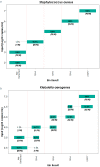Multicenter Evaluation of the BioFire FilmArray Pneumonia/Pneumonia Plus Panel for Detection and Quantification of Agents of Lower Respiratory Tract Infection
- PMID: 32350043
- PMCID: PMC7315029
- DOI: 10.1128/JCM.00128-20
Multicenter Evaluation of the BioFire FilmArray Pneumonia/Pneumonia Plus Panel for Detection and Quantification of Agents of Lower Respiratory Tract Infection
Abstract
The ability to provide timely identification of the causative agents of lower respiratory tract infections can promote better patient outcomes and support antimicrobial stewardship efforts. Current diagnostic testing options include culture, molecular testing, and antigen detection. These methods may require collection of various specimens, involve extensive sample treatment, and can suffer from low sensitivity and long turnaround times. This study assessed the performance of the BioFire FilmArray Pneumonia Panel (PN panel) and Pneumonia Plus Panel (PNplus panel), an FDA-cleared sample-to-answer assay that enables the detection of viruses, atypical bacteria, bacteria, and antimicrobial resistance marker genes from lower respiratory tract specimens (sputum and bronchoalveolar lavage [BAL] fluid). Semiquantitative results are also provided for the bacterial targets. This paper describes selected analytical and clinical studies that were conducted to evaluate performance of the panel for regulatory clearance. Prospectively collected respiratory specimens (846 BAL and 836 sputum specimens) evaluated with the PN panel were also tested by quantitative reference culture and molecular methods for comparison. The PN panel showed a sensitivity of 100% for 15/22 etiologic targets using BAL specimens and for 10/24 using sputum specimens. All other targets had sensitivities of ≥75% or were unable to be calculated due to low prevalence in the study population. Specificity for all targets was ≥87.2%, with many false-positive results compared to culture that were confirmed by alternative molecular methods. Appropriate adoption of this test could provide actionable diagnostic information that is anticipated to impact patient care and antimicrobial stewardship decisions.
Keywords: respiratory pathogens; respiratory viruses; syndromic panel.
Copyright © 2020 Murphy et al.
Figures

References
-
- GBD 2015 LRI Collaborators. 2017. Estimates of the global, regional, and national morbidity, mortality, and aetiologies of lower respiratory tract infections in 195 countries: a systematic analysis for the Global Burden of Disease Study 2015. Lancet Infect Dis 17:1133–1161. doi:10.1016/S1473-3099(17)30396-1. - DOI - PMC - PubMed
-
- Ramirez JA, Wiemken TL, Peyrani P, Arnold FW, Kelley R, Mattingly WA, Nakamatsu R, Pena S, Guinn BE, Furmanek SP, Persaud AK, Raghuram A, Fernandez F, Beavin L, Bosson R, Fernandez-Botran R, Cavallazzi R, Bordon J, Valdivieso C, Schulte J, Carrico RM, University of Louisville Pneumonia Study Group. 2017. Adults hospitalized with pneumonia in the United States: incidence, epidemiology, and mortality. Clin Infect Dis 65:1806–1812. doi:10.1093/cid/cix647. - DOI - PubMed
-
- Xu J, Murphy SL, Kochanek KD, Bastian BA. 2016. Deaths: final data for 2013. Natl Vital Stat Rep 64:1–119. - PubMed
-
- Ishida T, Hashimoto T, Arita M, Tojo Y, Tachibana H, Jinnai M. 2004. A 3-year prospective study of a urinary antigen-detection test for Streptococcus pneumoniae in community-acquired pneumonia: utility and clinical impact on the reported etiology. J Infect Chemother 10:359–363. doi:10.1007/s10156-004-0351-1. - DOI - PubMed
Publication types
MeSH terms
LinkOut - more resources
Full Text Sources
Medical

